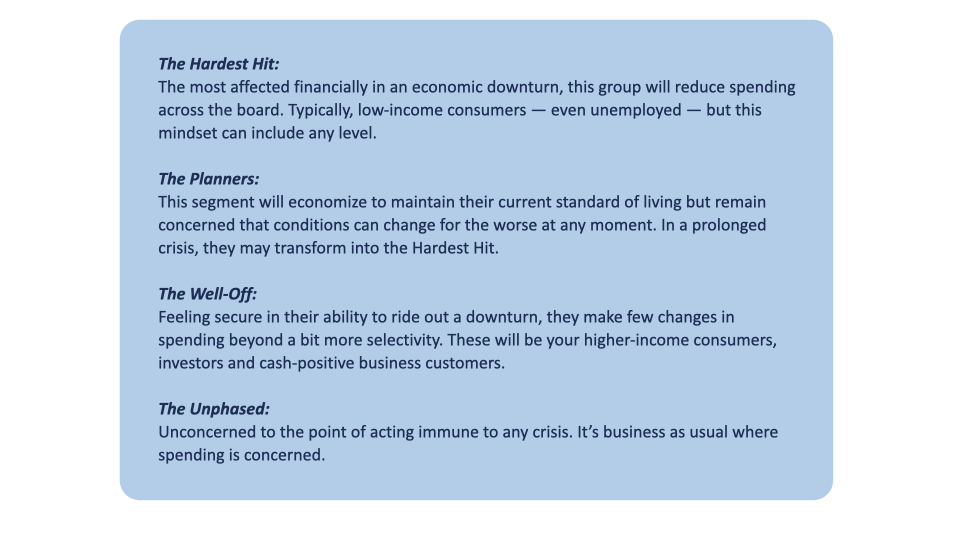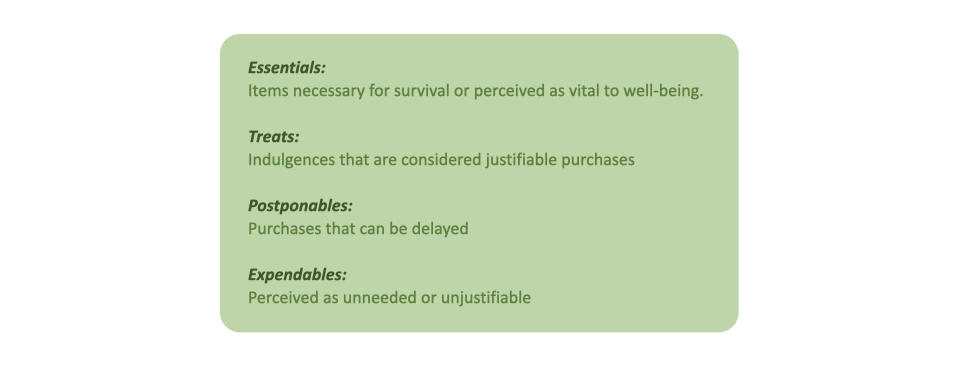
“Hope for the best, expect the worst.”
In troubled times, it’s classic counsel — not to mention being the title of a classic Mel Brooks’ song, at that. We’re all trying our best to keep a stiff spine as we collectively stare anxiously into the shadowy face of economic uncertainty (so far inflation is bad but we’re holding off a recession – fingers crossed).
The first quarter of 2022 saw the GDP contract by 1.51%, the first fall since that glorious year of 2020. With the supply chain continuing to wreak havoc and inflation smacking the wallets out of our hands, over 80% of consumers surveyed by the WSJ say the economy is “not so good.” Over 35% rated their own financial situation as “unsatisfied.” That’s reflected in a U.S. Census Bureau survey that notes a 32% increase in people relying on loans and credit cards to meet regular expenses, and a similar rise in those borrowing money from family and friends.
A recession isn’t a certainty — 37 economists polled by Bloomberg put the odds of a recession at just 30% over the next 12 months. But 30% ain’t nothing, either.
So, what’s a business to do? The “responsible thing” is to hunker down, approach with caution, and embrace austerity — or so the “responsible people” will say. Slash costs to ride it out! Let unused funds sit stagnant! Halt R&D and product development! Just sit back and wait for economic growth.
One of the easiest ways to cut spending? Reduce your marketing.
Reducing your marketing in an economic downturn can also be one of the riskiest. So, before you join the many oh-so-responsible as they go to ground, you may want to ask yourself a couple of key questions:
- Is yours the kind of business that follows — or leads?
- If everyone else is slowing down — where are the opportunities for your business to pull ahead?
The simple math is that less marketing = less visibility — and that’s both to new and existing customers. It could even send the message that you’re out of the category or worse, out of business — at exactly the time smart companies will be looking to take advantage of the situation and steal (your) market share.
As bad as it seems — as bad as it might get — the economy doesn’t slam the brakes on entirely. Consumer demand, and with it consumer spending, will continue. Which means you should spend some time considering how you will continue to remain top of mind for the buying decisions they will make.
The fact is, no matter how stormy the financial forecast or sharp an economic downturn, you have options. More than that, you have a responsibility to the business you’ve built, the people that work for you, and the customers that look to you for your unique products and services. We’ve identified 12 marketing-related initiatives and considerations that can help maintain momentum as you continue to adapt to a tumultuous economic cycle.
(These are not in a particular order. But they can provide a sense of order when chaos comes knockin’…)
1. Adjust Your Message to Match Customers’ Economic Impact
You need to protect the loyalty you’ve earned with your existing customers and continue to grow trust. Base some of your messages to them on how the economy has impacted them personally. Here is a framework for you to use – your customers will fall into these categories:

2. Insist on New Data for New Conditions
As available and discretionary income changes during an economic contraction, new data needs to be collected to understand your customers’ emotional state and how they make their purchasing decisions. Can’t you just use historical data from a prior hard time? That seems smart — even efficient.
But the truth is each economic downturn is caused by different factors. Market research on your target audience in these conditions will gain you insights that align you with your customers’ true needs, emotional state and behaviors — a competitive edge that will serve you well during and after any crisis.
3. Know the Product Categories That Customers Create
During an economic crisis, customers will simplify things by organizing the products and services they buy into four categories:

4. Practice Brutal Honesty with Yourself & Your Exec Team
Because marketing and communications costs can be trimmed quickly, you will face pressure — externally and from your gut — to sacrifice these efforts on the altar of austerity. You’ll no doubt hear (and even hear yourself say), “It’ll work out, just be optimistic…” It’s important to be equally vocal when it comes to the realistic consequences of undercutting your brand awareness.
There will be a “post-economic-incident hangover” (the lasting effects on sales and brand metrics) if you reduce your marketing efforts/budget – so, prepare others for the consequences (immediate and midterm) of pulling back on marketing. An exercise in brutal honesty with yourself and your leadership can be just what’s needed to revise your marketing strategy vs. eviscerating it.
While some cuts may be needed, this type of conversation can help achieve better buy-in for where to hold steady — even where to increase spending. Also worth an honest discussion: is forecasting what it will take to recover your marketing position post-recession if you cut your budget.
5. Find the Perfect “Goldilocks” in Your Message
Adjusting your marketing during economic change is an exercise in balance: you want to be sure you’re neither “Chicken Little” nor “Pollyanna.” And ultimately for your customers, your communications must continue to answer the question, “WIIFM?” — “What’s in it for me?”
Relevancy is even more true during economic downturns when needs and finances have no doubt shifted. You don’t want to seem tone deaf to the world at large, or the intimate concerns of an individual or business.
At the same time, you may find value in increasing the positive emotions/messages of your communications. The right type of “upbeat” can draw in certain customers — especially those seeking to feel good in tough times. (See above re: “Treats.”)
6. Take Advantage of the Situation to Renegotiate Contracts
You’re far from alone in your concerns and situation. Your marketing partners/vendors are facing and feeling the same pinch you are. Review your media, platform and tech contracts for opportunities to come to a new arrangement. Many vendors would rather take a smaller fee than lose your business outright — the current economic reality can work more to your advantage during negotiations.
7. Love the Ones You’re With

Your marketing efforts also serve your business when it comes to internal communications. As the world (seems) to crumble, your employees will be struggling with their own financial worries and workarounds, as well as creating their own anxieties. (“Business down…layoffs ahead?”) Internal marketing can provide critical positivity in terms of a vision for the future, the stability of the business and the return to a “normal state”.
You don’t need to be conjuring double rainbows — indeed, that risks coming across as out of touch or disingenuous. Instead, as in all things marketing related, you benefit most when you are a planner. It’s that steady hand — in message and action — that can help motivate your people and their concerns with a sense of security and purpose.
8. Beware the Fait Accompli
A “fait accompli” is “a thing accomplished and presumed irreversible.” In the case of economic worries, the negative nature of a dire situation can easily breed more bad. If you allow your operating principle to become “the worst is yet to come” — you may find yourself leaning into the defeatist decisions that create that exact worst-case scenario. Watch out for the faulty assumptions that fuel this negativity engine – visualize good things coming and they will.
9. Kick the Discount Addiction
The appeal of the discount is undeniable and addictive, especially in tough times. “Little effort for “cash back” at the point/time of sale? Sign me up!” But temporary price promotions to improve affordability can also change your customers’ perceptions of what your “normal” price really is.
This can threaten profitability when the economic recovery rolls around and you are looking to get back to your established price points. Marketing should make it clear that any discounts are “bonus offers” with “special conditions” for a “limited time.” (Anything inside those quotation marks would look great in a big burst. Just sayin’.)
10. Make Value the Center of the Universe
Especially as customers are being more careful in their choices, they will seek the maximum value. Value in tough times is more than price — it’s perceived in terms of what it can provide to individuals and other businesses based on their needs. Whether they seek the indulgence of “Treats” or are navigating the necessary choices of “Essentials,” your marketing can target them with messages that align your value with their value system — effectively giving customers “permission to buy.”
11. Experiment with the Real Benefits of Artificial Intelligence
In uncharted times, the standard playbook may not apply. It almost certainly will not achieve the same results. What about new, low-cost tools to try new things in your marketing and measurement?
How about Jasper for AI-supported writing of articles and social (plus Jasper just announced it can do what Midjourney can do and, in our opinion, Jasper is already 80% there compared to its competition); Midjourney for AI-interpreted art and graphics; Sparktoro for price-conscious research; and SurferSEO to reduce time in optimizing all that new content? (These are top-of-mind resources for experimenting — no implied endorsement or sponsorship applies!)
12. Hail to the King (Content)
Create (more) content that educates and inspires your target audience. This may seem self-evident but a surprising number of brands either cut their content budget. This is your chance to show them how your products, services and thinking help save them money or improve their situation.
Be the thought leader to help guide your customers through the downturn journey and back to recovery. Thought leaders tell content stories that demonstrate you know how to solve your audience’s problems.
When that content connection gets made, you have an audience more likely to stay with you — and buy from you — through a downturn. (You can also encourage existing customers to share their own experiences doing business with you, making them part of your content generation.)
Conclusion – Make Time to Plant Some Trees

Whether it’s a downturn or recession, there’s a wonderful Chinese proverb that advises, “The best time to plant a tree was 20 years ago. The second-best time is today.” (So far as we know, there’s no Mel Brooks’ song for this one.)
Don’t think of any economic downturn as a time to react — at least in a reactionary way. Better to plan — and to do so in a way that plans for the inevitable recovery as well. Think about your marketing as ways to:
• Watch your competition to see if they retract into their bunker — then pounce to steal their share!
• Focus on cost-effective channels that spread awareness
• Explore new opportunities that provide value to customers
• Gather data-fueled understanding that generates driven decisions
• Innovate new and more efficient offerings
Which direction will you choose? We’re all facing whatever comes next, so at IDLab we’re as interested in learning as we are in providing information and advice. Feel free to use us as a sounding board— and let’s see what we can discover together.
By the way… If you are looking for new channels to get your message out and new audiences to help insulate against a topsyturvy economy, read our article on How to Start Marketing in the Metaverse.




